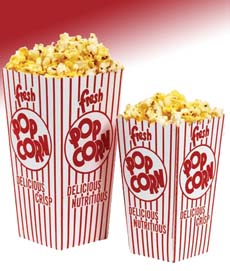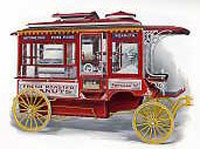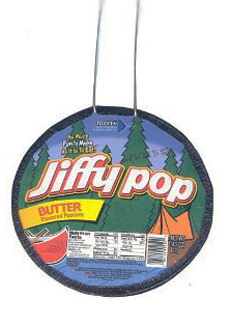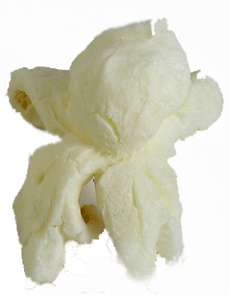

How did popcorn end up at the movies? This page explains all. Popcorn scoop boxes available from ePopcorn.com.
|
MELODY LAN is a member of THE NIBBLE editorial staff. |
|
July 2006
Last Updated September 2010
|
 |
Popcorn History
Page 3: The History Of Popcorn In The U.S.
This is Page 3 of a five-page article. Click on the black links below to visit other pages.
Popcorn In The “Modern” U.S.
Popcorn is an original American snack. Maize, called corn in most English-speaking countries, is a grass, the grains of which are corn kernels. Corn was domesticated by the indigenous people of Mesoamerica in prehistoric times—prior to the rise of the Maya and Aztec civilizations.
The ability of certain types of corn kernels to pop into food was discovered early along the way. Popcorn from 3600 C.E. was found in Native American caves in New Mexico.
As the cultivation of corn spread across the American content, the English who came to America in the 16th century learned about popcorn from Native Americans. Corn had come all the way from Mesoamerica to the east coast of the North American content.
Some sources say that Native Americans brought popcorn to the first Thanksgiving, at Plimouth Plantation. The way to eat popcorn at that time was to hold an oiled ear of corn on a stick over the fire, and then chew the popped kernels off the cob.
The Colonial Era
After this introduction, the colonists began to enjoy the first puffed breakfast cereal—a bowl of popcorn served with cream or milk. In the 18th century, after the corn harvest, rendered fat would be thrown into a cast iron pot over an open fire. When the fat was bubbling hot, the farmers would toss in corn kernels and a little molasses or other sweetener. Soon, the corn would pop into a sweet, hot treat—what we’d call kettle corn today (today, corn oil and sugar replace the fat and molasses).
The 19th Century
By the 1840s, corn popping had become a popular recreational activity in the U.S. By the 1870s, the treat was sold in grocery stores and at concession stands at circuses, carnivals and fairs.
In 1885, Charles Cretors, founder of the Chicago snack equipment company C. Cretors  and Co., invented the first commercial popcorn machine. In 1883 he introduced the first mobile popcorn machine at the Midway of Chicago’s Columbian Exposition. It was reported by the Scientific American that the apparatus weighed about 400 or 500 pounds, and could be easily drawn by a boy, pulled by a small pony or mounted on trucks. The photo of the popcorn wagon at the right is of the improved 1900s version of the original model. The Cretors popper allowed vendors to follow crowds, especially ones near movie theaters, creating the tradition of enjoying the popcorn at the cinema. and Co., invented the first commercial popcorn machine. In 1883 he introduced the first mobile popcorn machine at the Midway of Chicago’s Columbian Exposition. It was reported by the Scientific American that the apparatus weighed about 400 or 500 pounds, and could be easily drawn by a boy, pulled by a small pony or mounted on trucks. The photo of the popcorn wagon at the right is of the improved 1900s version of the original model. The Cretors popper allowed vendors to follow crowds, especially ones near movie theaters, creating the tradition of enjoying the popcorn at the cinema.
The 20th Century
Because of the mobile popper, popcorn was very popular from the 1890s onward. Street vendors pushed steam or gas-powered poppers throughout the nation, selling both popped corn by the bag or shaped into balls or squares, and unpopped kernels. At about the same time, flickers—or movies—were making their debut. By the early 1920s, popcorn was available at most movie theaters across the country, as much a part of the enjoyment as watching Charlie Chaplin and Greta Garbo.
At about a nickel per bag or a penny for a popcorn ball, people of all ages enjoyed popcorn and even strung the puffed kernels together as festive decorations.
Smaller machines were developed, and commercial poppers in theatres appeared in 1912. By 1945, nearly half the popcorn consumed in the United States was consumed in the soft glow of a movie screen, and by 1951, 96% of all U.S. cinemas sold popcorn in their lobbies. Riding the popcorn wave, home-cooks were inspired to develop recipes for everything from popcorn pudding, fritters and Cracker Jacks to chocolate-covered popcorn and popcorn brittle.
The Great Depression & World War
During the Depression (from 1929 through most of the 1930s), popcorn, at 10 cents a bag, was one of the few luxuries poorer families could afford.
While other businesses failed, the popcorn business thrived. During the sugar shortages of World War II (1939 to 1945) and there was so little sugar in the U.S. that candy production was limited, and Americans ate three times as much popcorn as usual.
Popcorn went into a slump during the early 1950s, when television became popular and movie attendance dropped. But when more consumers began making popcorn at home, the new relationship between television and popcorn led to a resurgence in popularity.
The Launch Of Jiffy Pop
The launch of Jiffy Pop’s easy stovetop popper in 1959 increased the popularity of popcorn as a home snack.
This ingenious device, invented by Fred Mennen of Indiana, is essentially an aluminum foil cake pan with a handle attached. The pan is filled with popcorn kernels in oil and covered with a pleated sheet of foil.
Part of the fun is watching the flat top balloon into a huge sphere of popped corn.
If you’ve never seen one of these disposable aluminum poppers, take a look.
|
|

Jiffy Pop is available at Amazon.com. |
Microwave Popcorn
Where would we be today without microwaveable popcorn. Even though the microwaving of popcorn was patented in 1949*, it didn’t appear in the marketplace until 1984. Why?
*By Dr. Percy Spencer, who first discovered the ability of microwaves to cook food in 1946.
- First, someone had to invent the microwaveable popping bag. This was done by two food scientists at Pillsbury, Lawrence C. Brandberg and David W. Andreas, who filed for the patent in 1973.
- Next, it had to be made shelf-stable. The first microwaveable popcorn, ACT I, had to be stored in the refrigerator. ACT II, a shelf-stable microwave popcorn, was launched in 1984—the first mass-marketed microwave popcorn. It was manufactured by Golden Valley Microwave Foods (GVMF) company of Edina, Minnesota. The company was purchased by ConAgra Foods in 1991.
Popcorn Today
Recovery of the movie industry, which saw its annual admissions double between 1971 and 2002 also helped with popcorn sales. In 2004, cinemas sold about 60 million pounds of popcorn, and—if you can believe statistics—the average American ate 70 quarts. Today, Americans consume about 17 billion quarts of popped corn each year. Much of it is grown in Indiana; Nebraska produces a large crop as well.
The “mushroom"-shaped popcorn at left is less fragile and also less tender than “butterfly” shape.
Continue To Page 4: Flavored Popcorn
Go To The Article Index Above
|
|

Most commercial popcorn today pops in the “mushroom” shape, above. The “butterfly” shape, below, is more fragile and tender. Photos courtesy Wikimedia.
 |

|





 and Co., invented the first commercial popcorn machine. In 1883 he introduced the first mobile popcorn machine at the Midway of Chicago’s Columbian Exposition. It was reported by the Scientific American that the apparatus weighed about 400 or 500 pounds, and could be easily drawn by a boy, pulled by a small pony or mounted on trucks. The photo of the popcorn wagon at the right is of the improved 1900s version of the original model. The Cretors popper allowed vendors to follow crowds, especially ones near movie theaters, creating the tradition of enjoying the popcorn at the cinema.
and Co., invented the first commercial popcorn machine. In 1883 he introduced the first mobile popcorn machine at the Midway of Chicago’s Columbian Exposition. It was reported by the Scientific American that the apparatus weighed about 400 or 500 pounds, and could be easily drawn by a boy, pulled by a small pony or mounted on trucks. The photo of the popcorn wagon at the right is of the improved 1900s version of the original model. The Cretors popper allowed vendors to follow crowds, especially ones near movie theaters, creating the tradition of enjoying the popcorn at the cinema. 

